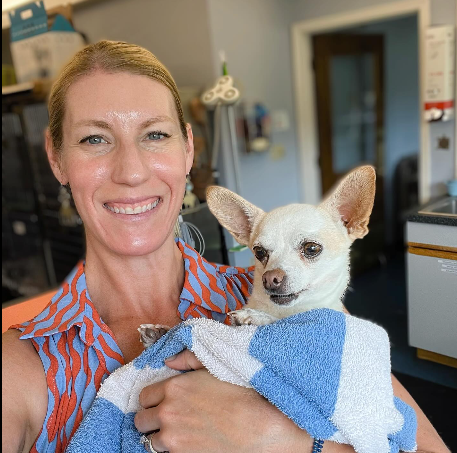It might be upsetting for pet owners to witness their dog chewing its tail so obsessively that it cuts itself or bleeds. Tail chewing, sometimes referred to as self-mutilation, is a behavior that may indicate a more serious problem. Dogs often chew on their tails for a variety of reasons, from medical issues to behavioral issues. In order to successfully treat the issue, it is essential to comprehend the underlying cause of this excessive and hazardous conduct.
In dogs, tail biting may be an indication of stress, worry, or discomfort. Physical issues including an allergic response, parasites, or impacted anal glands can also cause it. A dog may also indulge in this self-destructive activity out of boredom or a lack of mental and physical stimulation. For effective intervention and resolution, determining the precise trigger causing your dog to chew on its tail is crucial.
This conduct not only puts one in danger physically but may also point to underlying problems that require addressed. Understanding the causes of tail chewing and getting the right advice from a veterinarian are essential first steps in protecting your pet’s health and well-being.
Figure out the underlying problem
Recognizing the habit in which a dog obsessively chews or gnaws at their tail—often to the point of damage or bleeding—is essential to understanding tail chewing in dogs. It’s an unsettling behavior that has to be addressed because it may be a symptom of something more serious. Dogs chew their tails for a variety of reasons, from behavioral and emotional cues to possible health issues. For effective intervention and resolution, it is imperative to identify and comprehend the motivations underlying this conduct. Understanding and treating tail chewing in dogs requires keeping an eye out for patterns, speaking with a veterinarian, and taking the whole picture of their life and health into account. This knowledge is the first step toward figuring out the underlying problem and giving a dog that is self-injurious the assistance and care that it needs.
Anxiety as a Trigger
Dogs that bite their tails may do so as a reaction to anxiety. Dogs who are anxious or stressed out may bite their tails to self-soothe. This is a coping technique. Finding and treating the causes of anxiety is essential to reducing this behavior. Reassurance, a safe, consistent environment, the use of calming methods, and possibly expert advice can all assist minimize anxiety, which in turn lessens the chance of tail biting. In addition to reducing tail biting, recognizing and treating the underlying causes of anxiety improves a dog’s emotional health in general.
Stress-Induced Tail Chewing
Stress-related tail chewing in dogs is a worrying activity that can be brought on by a variety of environmental stressors. Stress can take many forms, and frequent tail-chewing is one way that it might show up as a self-harming habit. When faced with new or frightening events, routine changes, environmental changes, or other stressors, dogs may turn to this behavior as a coping method. It is possible to considerably lower the probability of stress-induced tail chewing by identifying these stressors and taking steps to lessen or remove them. Stress can be reduced and dogs’ likelihood of engaging in this behavior reduced by offering a stable, secure, and predictable environment as well as positive reward and assurance. It is advisable to speak with a veterinarian if this behavior continues or gets worse.
Allergic Reactions
A dog may begin to bite its tail due to an allergic reaction. Allergies can cause itching and discomfort, which can result in excessive biting or chewing, particularly in the area surrounding the tail. Stopping this behavior requires determining which allergen is causing the reaction and taking appropriate action. By using tests or observations, a veterinarian can assist in identifying possible allergens and make recommendations for suitable medications or dietary or environmental modifications to help the dog experience less allergic reactions. Resolving allergic reactions helps dogs feel less uncomfortable and less tempted to bite their tails as a result of the aggravation these allergic triggers produce.
Parasites’ Role in Tail Chewing
A dog’s motivation to chew on its tail may be greatly influenced by parasites like fleas or mites. These foreign parasites can irritate and distress the dog, causing it to concentrate on the affected area and frequently chew excessively. Dogs may nibble or bite at their tails in an effort to ease their suffering due to the itching and irritation caused by parasites. To avoid and manage this problem, a veterinarian’s recommended regular flea and tick treatments could be part of an efficient parasite management program.
Not only can prompt removal of parasites ease the dog’s discomfort, but it also helps lessen the dog’s urge to chew on its tail as a result of irritation from these outside invaders. Consulting a veterinarian becomes essential to address the underlying cause of tail chewing if it continues despite parasite control efforts..
Impacted Anal Glands as a Factor
Tight anal glands may be a factor in dogs’ tendency to chew their tails. These glands, which are situated close to the anus, generate a smell when a person urinates. These glands can become impacted or clogged, which can be uncomfortable and cause the dog to show signs of discomfort or irritability. The dog may gnaw or chew on their tail to ease their discomfort as a result of this. Frequent expression of these glands, usually by a veterinarian, helps avoid discomfort and impaction. It becomes crucial to see a veterinarian if a dog exhibits tail chewing on a regular basis despite gland expression. This is to make sure that there are no underlying problems that could be causing the gland problems or discomfort, which would then result in the tail chewing activity.
Linking Boredom to Tail Chewing
When dogs’ tail-chewing habit is linked to boredom, it suggests that their conduct may be a reaction to a lack of mental or physical stimulation. Just like us, dogs enjoy interaction and activity. They may revert to activities like tail-chewing to relieve boredom or seek stimulation when faced with extended periods of inactivity or a lack of cerebral stimulation. This dullness can be fought by creating an enriching atmosphere with engaging toys, regular exercise, and mental challenges. Engaging a dog’s mind and body through activities such as puzzle toys, walks, play sessions, or training exercises can decrease the probability of the dog turning to tail chewing as a form of stimulation. It’s critical to acknowledge and treat the connection between boredom and tail-chewing in order to protect a dog’s general wellbeing and lessen the appearance of behavior.
How to Stop Your Dog’s Tail Biting
Providing Mental Stimulation
Addressing your dog’s tail biting involves various strategies, with mental stimulation being a key element. Engaging your dog’s mind with activities such as puzzle toys, training exercises, or interactive games can divert their focus from tail biting. Mental challenges not only occupy your dog’s attention but also provide a constructive outlet for their energy and curiosity, reducing the likelihood of resorting to tail biting. Introducing new toys or rotating existing ones keeps the activities novel and engaging, stimulating their cognitive abilities and promoting a healthier, more mentally active lifestyle for your dog. Offering Comfort to Your Dog
Supplying Engaging Toys
Having entertaining toys available is a great way to stop your dog from biting its tail. Giving them a range of sturdy, engaging, and interactive toys will divert their attention from biting their tails. Chew toys, interactive balls, puzzle feeders, and toys that shoot goodies are examples of toys that promote both physical and cerebral activity, giving your dog a constructive way to release some of its energy. These toys improve your dog’s general wellbeing and help stop this self-destructive tendency by diverting their attention from the impulse to bite their tail and by offering amusement and mental stimulation.
Consulting with a Veterinarian
One of the most important steps in dealing with your dog’s tail-biting tendency is seeing a veterinarian. To identify possible underlying causes, such as allergies, parasites, or illnesses that could cause tail biting, a veterinarian can perform a comprehensive examination. To address this habit, they can offer specialized advice, advise therapies, or make behavioral interventions suggestions.. Visiting a vet guarantees a thorough assessment of your dog’s health and aids in creating a strategy to stop tail-biting that will make your pet live a longer, healthier life.Think about Elizabethan collars.
Promoting Physical Exertion
Providing your dog with physical stimulation is a good way to stop them from biting your tail. Frequent playtime, physical activity, and exercise help them focus their energies and relieve tension, which eventually lessens the temptation to bite their tail. In addition to giving them an outlet for their physical energy, activities like fetch, walking, jogging, and interactive games also improve their general wellbeing. By encouraging physical exercise, you can divert their attention and energy from tail-biting to constructive and beneficial behaviors.
Conclusion
A multifaceted strategy is needed to address your dog’s tail-biting behavior, which includes locating and addressing potential triggers. You can take specific action to lessen the impulse to bite their tail by being aware of the different triggers, such as boredom, anxiety, allergies, or physical pain. Key tactics for reducing this behavior include offering mental and physical stimulation, consulting a veterinarian, and establishing a safe, comforting environment. Tail biting frequently indicates an underlying issue and is not merely a physical problem. Recognizing and resolving these underlying issues guarantees your pet’s general wellbeing and pleasure in addition to the behavior’s termination.
Po

Dr. Allison Kramer is a seasoned veterinarian with a Master’s degree in Animal Behavior and over 10 years of experience specializing in canine health and behavior. Her expertise in positive reinforcement training and holistic care enhances the well-being of dogs and fosters strong pet-owner relationships. For expert advice and valuable insights, follow Dr. Kramer on Instagram @dr.allisonkramer.





